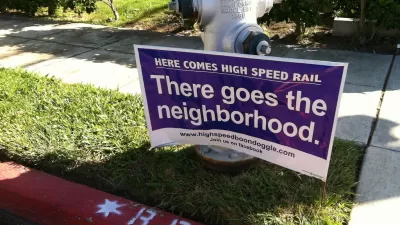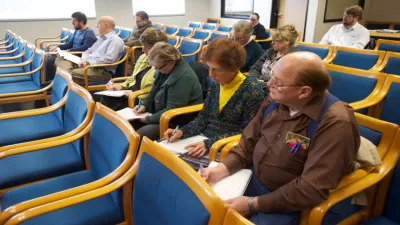"To get beyond NIMBYism, we first must understand it," writes Richard Florida.

Richard Florida shares insights into a recent white paper published in December 2016 by Paavo Monkkonen, which "sheds interesting new light on the connection between NIMBYism and housing affordability. It takes a deep dive into, on the one hand, neighborhood opposition and land use restrictions, as well as housing supply and housing costs in Los Angeles, San Francisco, and California’s other expensive housing markets."
According to Florida, Monkkonen identifies in the white paper "four different strains of NIMBYism and their underlying motivations." That taxonomy of opposition, with more detail in the article responds to the following concerns: 1) traffic and parking, 2) strains on services, environmental preservation, and 4) neighborhood character.
Monkkonen also posits four strategies for surmounting the obstructionist effects of NIMBYs: 1) better use of existing housing policies, 2) inclusive planning, 3) better data, information, and nonpartisan analysis, and 4) and a shift in land use power to the regional level.
Not mentioned in Florida's analysis of the white paper (but another motivating factor for NIMBYism that often goes unrecognized) are communitarian interests (as opposed to self-interest, i.e., concern about property values), as described in a blog post by Prof. Lisa Schweitzer last year.
FULL STORY: Anatomy of a NIMBY

Planetizen Federal Action Tracker
A weekly monitor of how Trump’s orders and actions are impacting planners and planning in America.

Maui's Vacation Rental Debate Turns Ugly
Verbal attacks, misinformation campaigns and fistfights plague a high-stakes debate to convert thousands of vacation rentals into long-term housing.

San Francisco Suspends Traffic Calming Amidst Record Deaths
Citing “a challenging fiscal landscape,” the city will cease the program on the heels of 42 traffic deaths, including 24 pedestrians.

Defunct Pittsburgh Power Plant to Become Residential Tower
A decommissioned steam heat plant will be redeveloped into almost 100 affordable housing units.

Trump Prompts Restructuring of Transportation Research Board in “Unprecedented Overreach”
The TRB has eliminated more than half of its committees including those focused on climate, equity, and cities.

Amtrak Rolls Out New Orleans to Alabama “Mardi Gras” Train
The new service will operate morning and evening departures between Mobile and New Orleans.
Urban Design for Planners 1: Software Tools
This six-course series explores essential urban design concepts using open source software and equips planners with the tools they need to participate fully in the urban design process.
Planning for Universal Design
Learn the tools for implementing Universal Design in planning regulations.
Heyer Gruel & Associates PA
JM Goldson LLC
Custer County Colorado
City of Camden Redevelopment Agency
City of Astoria
Transportation Research & Education Center (TREC) at Portland State University
Jefferson Parish Government
Camden Redevelopment Agency
City of Claremont





























